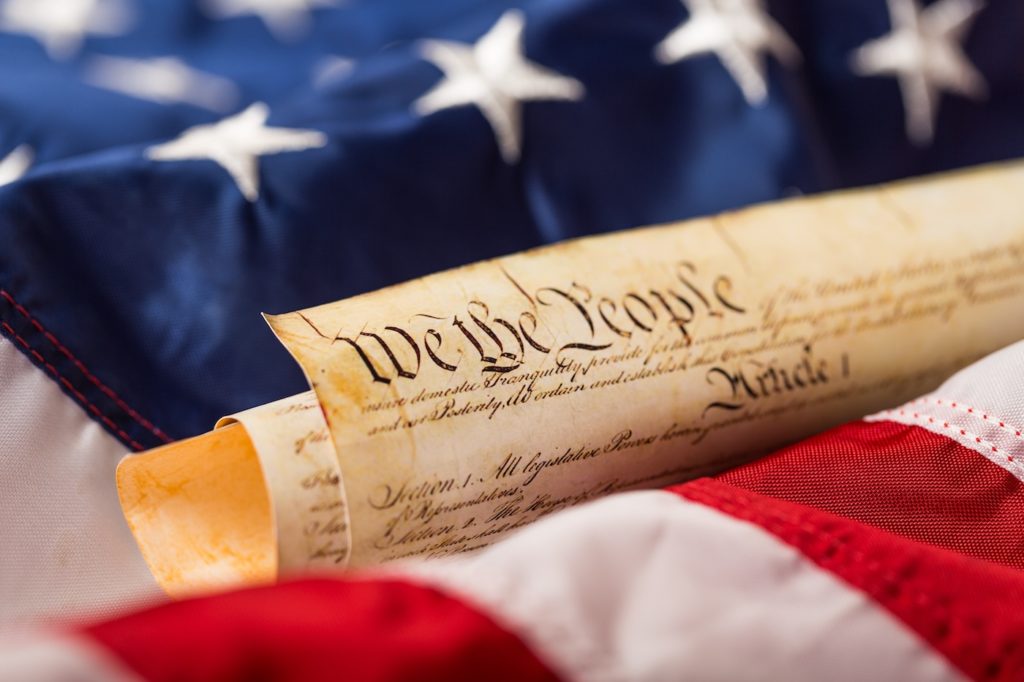Those of us who have taught for many years have spoken or written variations of the same message to students, individually or in whole classes, many times: When making your own arguments against those of others, you are obliged to give your interlocutor or opponent the strongest form of his own argument, not the weakest. No straw men, no cherry-picking the weakest representations of a view you reject, no pretending that a complex school of thought of many members can be dismissed by “defeating” just one or a few of them. And assertions are not evidence.
By these venerable pedagogical principles, Adrian Vermeule’s Common Good Constitutionalism would constitute the submission of a failing thesis. Mind you, there are good things in this book; but it is not a good book, and the principal reason is that Vermeule’s polemical opposition to anything traveling under the banner “originalism” in American constitutional law overwhelms his critical and historical judgment.
But let us do Vermeule, who teaches at Harvard Law School, the justice of restating his argument. In his account, constitutional law in America’s academies and courts is presently a war between “originalists” and “progressives,” both of whom “attempt, in different ways, to reduce all law to positive law.” What is lost, he avers, is the wisdom of the classical legal tradition, a grounding of positive law in natural law that descended from late Roman jurisprudence through the ius commune, via the English common law, to the founding statesmen and early jurists of the American republic. This legal tradition prevailed in American law and legal thinking nearly through the nineteenth century, and in some respects even into the twentieth. But progressivism put paid to the tradition, displacing it with a vision of “endless liberation through the continual overcoming of the reactionary past.”
What was lost in this modern fit of pique was an understanding of the common good as “the flourishing of a well-ordered political community,” a flourishing that did not merely aggregate individual interests, and did not prize rights over duties or liberty over authority, but understood all these things as subject to ordering by public officials and judges according to “objective principles of legal justice accessible to the reason.” Human beings are naturally social animals, and the responsibility of public authorities is to seek their good in society—their well-being in relation to one another and the whole—by fostering peace, justice, and the general welfare, understood both materially and morally. And all positive laws promulgated to these ends are to be construed (and in the exceptional case, set aside) according to the dictates of natural law, which has “its own binding force.” Our constitutional law, Vermeule argues, can only be restored to health when its relationship to this classical legal tradition is reestablished.
Start your day with Public Discourse
Sign up and get our daily essays sent straight to your inbox.Some but not all of the foregoing might be embraced by scholars who call themselves originalists. But Vermeule is not seeking allies among them; he treats them all as dragons to be slain—or perhaps as a much lower order of creatures to be stamped on. For him, originalism is a wholly modern phenomenon, nonexistent before the mid-twentieth century. It is “an extreme latecomer” in the development of legal thought, a “relatively recent innovation” that is “profoundly anachronistic, indeed counter-originalist.” It is merely the ideology of a “conservative legal movement” that espouses a “substantively libertarian constitutional vision.” But it has “a horror of judgment.” The fact that there are “endless, variant definitions of originalism” suggests that it is “an unstable research program.” There are, it seems, too many theoretical epicycles being spun out by the originalists, with all their internecine quarreling, for their collective output to be taken seriously. Yet on the other hand, Vermeule’s favorite epithet for originalism is that it is “an illusion” (at one point he goes so far as to say it “doesn’t exist”), because it suffers from a “lack of theory,” and has “no internal theoretical resources” for choosing the “level of generality” at which it should read various constitutional provisions and principles.
An Unreasonable Attack on Originalism
In Vermeule’s telling, then, originalism is both too various in its theories and entirely impoverished of theory. It takes many forms, but that means it is weak, not strong, and the proof is evidently that in one of its manifestations, which is representative on the author’s ipse dixit, it is wholly positivist and libertarian—but somehow afraid to judge. All this dismissal of originalism as a failure, I would note, is carried on at length without much discussion of whom (as opposed to an abstracted what) Vermeule intends to dismiss. The tone throughout is that the author is above mere argument with his fellow toilers in the vineyard of scholarship. Instead he chooses “three recent examples from the Roberts Court” as his illustrations of originalism’s “illusory character.” Readers will be excused for thinking Vermeule’s choice of examples is convenient for his own argument.
The tone throughout is that Vermeule is above mere argument with his fellow toilers in the vineyard of scholarship.
One of those examples is the infamously fallacious “originalist” opinion of Justice Neil Gorsuch in Bostock v. Clayton County (2020), extending Title VII civil rights protection to persons on the basis of their sexual orientation or “gender identity.” Noting that there were dissenting opinions offering originalist reasoning for the opposite outcome, Vermeule remarks: “If originalism is so difficult that one of its leading champions cannot apply it correctly, one might conclude that originalism is simply a dangerously unreliable technology, one that induces fatal rates of human error.” Or one could conclude that the majority opinion was written in bad faith, with a particular outcome in mind—a perennial problem that no mode of jurisprudence can solve, not even a classical devotion to the common good.
Could there be peace and reconciliation between originalists and this warrior for the classical legal tradition? After all, originalism commonly holds that there is a moral obligation for judges and other public officials to bind their decision-making to the original meaning of the Constitution as a law promulgated for the common good. If the text of this highest of our positive laws was penned with certain background principles of natural law and the ius commune uppermost in the minds of the generation promulgating it, perhaps its present-day interpretation could be rendered both more authentic to the text and more just by a melding we might call “classical originalism.”
Vermeule is having none of it, writing that “all attempts to combine originalism with the classical view of law are ultimately incoherent, an attempt to mix oil and water.” The only such attempt he considers at all in the text, however (mentioning a couple of others in an endnote), is a recent article by law professors Jeff Pojanowski and Kevin Walsh. In Vermeule’s judgment, their argument “either fails to state a view different than the classical law, or, to the extent it is distinctive, fails on its own terms.” This is neatly put: What agrees with me is right, and what differs is wrong. But a fair-minded reader of Pojanowski and Walsh (click the link, if you please) cannot conclude that Vermeule has shown where they are wrong. And one will not learn from Vermeule anything meaningful about why they conclude (in their words) that a “practically reasonable interpreter seeks to understand the reasoned choices the framers made when enacting the positive law that constitutes the frame of government.”
In a similar vein, after reading a critique of his view by the legal scholar Joel Alicea, arguing for a natural-law basis for the judge’s moral obligation to be an originalist, Vermeule and a co-author commented online that Alicea “adds nothing at all distinctively ‘originalist’ to what we take the classical legal tradition to entail,” and that they had no substantive disagreement with the ho-hum originalism he espoused, which otherwise didn’t say much of anything. Consider, then: for Vermeule, originalism must be a positivist enterprise. As such, any account of it that eschews positivism either is not originalism as he understands it, or merges at least partly into his own position, and to the extent that it differs is in fact positivist and therefore wrong. Heads he wins, tails you lose. This is not common-good constitutionalism; it’s Calvinball constitutionalism. Like Calvin in the old cartoon, Vermeule sets the rules for the game—but willfully changes them from one play of the game to the next.
A Careless Approach to the Constitution
Vermeule notes early in the book that arrangements like our Constitution represent what the classical tradition called determinatio, the specification of positive-law norms fulfilling the ends of natural law. And he rightly notes that “the common good does not, by itself, entail any particular scheme of (for example) judicial review of constitutional questions, or even any such scheme at all.” But it turns out that this vitally important matter of determinatio interests him very little. For Vermeule, the holder of an endowed chair in constitutional law, has relatively little to say about the Constitution in this book on constitutionalism, or about the history of its adoption and interpretation.
Several times he asserts that the members of the founding generation and our earliest jurists were not originalists, evincing an unfamiliarity with the ample evidence to the contrary (see, for starters, this book by legal historian Johnathan O’Neill)—but remember, by Calvinball rules “originalism” did not exist until about a half century ago. Vermeule asserts that the founders were (instead) “classical lawyers,” which may be true if we understand them in a certain way but elides the extent to which the classical legal tradition they inherited had been inflected by the modern political theories of Locke and Montesquieu, and filtered through works like Blackstone’s Commentaries, which were influenced by those modern thinkers. John Marshall, to take just one of those classically trained lawyers, regarded the “written constitution” as America’s “greatest improvement on political institutions”—and was first and last an originalist because of his classical understanding of law.
In another sign of Vermeule’s casual approach to the Constitution’s text and history, he approvingly tells us, without any effort to establish its credentials constitutionally, historically, or morally, that “the federal government for all intents and purposes has acquired by prescription, over time, a de facto police power.” As to certain things, employing certain enumerated or implied powers, this is substantially so; as a general assertion, without substantial qualification, it is not so at all, as any observer of American federalism even in its present wounded state can see.
Like Calvin in the old cartoon, Vermeule sets the rules for the game—but willfully changes them from one play of the game to the next.
Similarly, he regards the Preamble’s reference to “the general welfare,” and the reappearance of that phrase in the enumerated taxing and spending power, as warrant for a “classical reading” of the federal government’s power to pursue the common good in ways largely undifferentiated from the powers of states and localities. Later, in a discussion of subsidiarity, Vermeule writes that “at the highest level of the polity . . . there should exist a public authority with the jurisdiction to act, under exceptional circumstances, where the operation of subsidiary institutions fails, so as to promote the common good throughout the polity.” As a normative constitution-framing principle, this may be appealing. But the question for constitutional interpreters is, does such a public authority exist with such jurisdiction in the circumstance presently before us? Sometimes it will, and sometimes it won’t. Vermeule’s principle was in fact part of James Madison’s Virginia Plan at Philadelphia in 1787, and it was rejected in favor of delegated and enumerated powers stated with some degree of specificity.
Notwithstanding its roving commission for judges, Common Good Constitutionalism is not a brief for government by judiciary. Vermeule, whose previous work has most notably been at the intersection of constitutional law and administration, would like judges generally to defer to any reasonable pursuit of the common good undertaken by legislatures and executives (though his unexamined presupposition that judges can always nullify “unreasonable” legislation does evince a casual embrace of judicial supremacy). The strongest section of the book, in fact, is the one on the administrative state, where the author is clearly most at home. Yet he does not acknowledge that even here matters could be otherwise if Congress were to revise such statutes as the Administrative Procedure Act. And his case for the highly evolved “current body of administrative law” is largely consequentialist: Vermeule has seen it, and it is good.
A Partial Perspective on Judicial Decisions
The stock in trade of the modern legal scholar is the analysis of judicial decisions. How does Vermeule fare on this count? So-so. When he assays the “stolen valor” case of United States v. Alvarez (2012), for instance, in which the Supreme Court struck down on free-speech grounds a law against fraudulent claims of unearned military honors, Vermeule slams the controlling opinion of Justice Anthony Kennedy for failing to consider the “public and common good” of “the military honors system.” But the very thing needful for a correct decision in this case, a consideration of “the integrity of the honors system,” was exactly what was offered by the dissent of Justice Samuel Alito, joined by Justices Antonin Scalia and Clarence Thomas. Vermeule never even mentions this dissent. Is he averse to crediting the originalist justices with anything?
Or consider Vermeule’s extended treatment of what he takes to be a model case in the classical tradition, the 1889 decision of the New York Court of Appeals in Riggs v. Palmer. This case concerned the inheritance rights of a grandson, named an heir in his grandfather’s will, who (as a minor) murdered the old man, and later claimed his inheritance. Under common-law norms governing wills, the murderer would not be able to inherit. But the New York legislature had codified the law of inheritance in a statute that made no exception in such cases, and indeed seemed by its terms to rule out any exceptions other than the few it specified. The court assimilated the statute to the common-law norms, an outcome Vermeule applauds. He goes even further, asserting that even the dissenting judge in the case was “just as deeply engaged with the classical tradition as the majority is,” and considered “general principles of law” to control the case just as much as the legislature’s determination.
But Vermeule does not tell us two things. First, he begins quoting the dissent in Riggs a few sentences after the most important ones that tell against his reading, which are these:
[I]f I believed that the decision of the question could be affected by considerations of an equitable nature, I should not hesitate to assent to views which commend themselves to the conscience. But the matter does not lie within the domain of conscience. We are bound by the rigid rules of law, which have been established by the legislature, and within the limits of which the determination of this question is confined.
The second thing he does not tell us (but that Judge William Pryor of the Eleventh Circuit has recently pointed out) is that Riggs was an outlier decision—that in fact, as Pryor recounts, “most American courts of that era rejected Riggs in favor of the textualist approach [Vermeule] says was invented after the Second World War.” The rejection of Riggs did not lead to a wave of murderous heirs, but rather to revision of thoughtlessly drafted statutes where necessary.
What is still worse, Vermeule attributes to Justice Scalia the view that laws must be interpreted to avoid “absurd results”—which is true—and then says that this is “precisely the view of the majority in Riggs v. Palmer.” But Scalia and his co-author Bryan A. Garner, in their book Reading Law (the very source he cites), took a much more constrained view of the absurdity doctrine than Vermeule does, and partly for that reason explicitly rejected Riggs as wrongly decided. You won’t learn this from Vermeule, either.
There is more of the same throughout this book, with applause for dubiously reasoned opinions by Justice John Marshall Harlan in Lochner v. New York (1905), by Justice George Sutherland in United States v. Curtiss-Wright Export Corp. (1936), and others besides that I haven’t space to consider here. I began to think I should read or reread every source in his endnotes to check on what he was omitting or mischaracterizing.
Common Good Constitutionalism, as I said, is a book that has some good things in it. It is good to be reminded that there is a historical continuity of American law with the classical legal tradition. And there are passages here in which Vermeule ably explains how the development of doctrine works, drawing on the doctrinal theology of John Henry Newman. But his book as a whole is quite undone by his intemperate rejection of modern originalism and his evident belief that all of our positive law is ultimately to be assimilated to what judges believe is reasonable in pursuit of the common good. If law has its own integrity, Adrian Vermeule has unwittingly demonstrated how heedlessly it can be abandoned.














